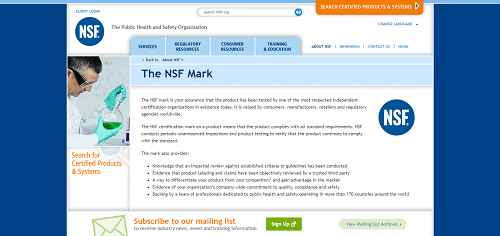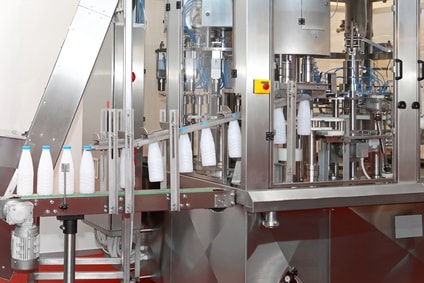If you are a producer of consumer and retail food and nutritional products, then you know just how important it is to deliver safe products to the public. When it comes to consumer safety, the United States is particularly unique in the way that it imposes strict and highly-rigorous testing on producers like yourself, which can be a blessing for the public, but it can also add challenges to production and innovation.

Companies in the food production industry strive for the NSF mark, which serves as an “assurance that the product has been tested by one of the most respected independent certification organizations in existence today.” It’s a useful tool that gives producers of retail food and nutritional products the freedom to experience hassle-free inspections and to rest free knowing that you are providing your customers with the safest products possible.
A Definition of NSF Food Equipment Standards
To fully grasp the wide-reaching power of the NSF mark, you must first understand its background. NSF International was initially formed in 1944 under the name National Sanitation Foundation. Since then, it has outgrown its domestic influence and now has established offices on six continents. NSF marks are given to products, pieces of equipment, and systems only after they have undergone testing by an impartial third party.
This non-profit organization has always stayed true to its original mission: to provide producers and, ultimately, consumers with the safest and most hygienic food equipment possible. This is ensured through stringent physical and material evaluations, as well as facility and product audits. The international reciprocity is an important one as it guarantees that food and nutritional products and systems, specifically, are safe for human consumption as they get imported and exported around the globe. Examples of this special equipment include everything from storage freezers to food and beverage dispensing equipment.
The Key Benefits of Following NSF Food Equipment Standards
Obviously, compliance with regulatory standards is a must in any industry to avoid penalties, but in the food manufacturing industry, it’s also a hallmark of the world’s most reputable companies. Benefits of compliance include:

- Producers benefit from compliance- As mentioned above, anyone who holds even a superficial understanding of food safety regulations knows that there is nothing lax about undergoing an inspection or audit. Regulatory powers make it this way in order to keep consumers safe, but even one simple mistake on the part of a negligent employee or one faulty piece of equipment could force you to shut down operations. That’s why responsible producers look for the NSF mark; although certain variables might be out of your control in regards to staff, you can rest assured knowing that your equipment was engineered to pass strict testing.
- Consumers benefit from safety regulations- While not everyone in this world has a place in the food production or service industries, everyone is a consumer. These strict food equipment standards were designed to safeguard the public from foodborne illnesses and diseases stemming from materials that are susceptible to contamination. In fact, the NSF standards are the international gold standard that currently reach across over 50 categories of products and systems. Simply put, it’s a necessary step in a holistic puzzle that keeps all of us safe from food contamination.
Challenges of Following NSF Food Equipment Standards
Remaining compliant isn’t always simple, and there are a few challenges associated with NSF compliance:
- Extensive training may be required- You might equip your entire facility with pieces of equipment that hold the NSF mark, but that doesn’t mean that you will automatically pass a surprise inspection if your employees have not received NSF best practices training. Because NSF also covers systems, it’s key that you provide your workers with sufficient knowledge of the equipment or processes in which they are using–as well as the consequences that might arise if they are to deviate from the standards. This can be a particularly trying challenge for companies, but it’s one that must be tackled for the sake of the business and its consumers.
- Extensive knowledge of your supplier is key- Your business may produce a product that is made mostly in your own facility, but it’s incredibly rare for any business to produce each and every component of their product. Because of this, you are doing a disservice to your consumers if you do not do your due diligence to confirm that each and every component in your supply chain is properly using its NSF-marked food safety equipment. The challenge here, of course, comes in the form of quality control; you are never going to see all of the processes of your suppliers in action, but you can access up-to-date audits and inspections. At the end of the day, if your company’s name is on the product and advertising materials, you are held responsible in the eye of the public if any food safety standards are breached.
A Quick Review on Why NSF Food Equipment Standards Are Essential for International Food Safety
The safety of the world’s food supply is paramount to population health. To recap, here’s why the NSF Food Equipment standards matter:
- Pieces of equipment that hold the NSF mark have undergone series of rigorous testing by third-party groups to guarantee that the food that comes in contact with them is being produced and handled in the safest manner possible.
- The NSF mark is an international symbol that safeguards consumers around the world. It acts as a benchmark for food products that are imported and exported to guarantee that the same safety standards are followed globally.
- The transparency helps producers ensure that their various suppliers are following strict food safety regulations through NSF-marked equipment and approved systems.
Related Posts:
- 5 Equipment Trends to Watch in the Food Service Industry
- What is the Globally Harmonized System (GHS)?
- What Are UL 969 Standards for Marking and Labeling? Certification Steps, Categories, and More
- The Life-Saving Importance of Medical Labels

